Corporations and Business Structures
VerifiedAdded on 2023/01/20
|6
|2102
|41
AI Summary
This document provides a comparison of the setup and administration costs associated with different business structures such as sole traders, partnerships, and proprietary companies. It explains the liability of partners in partnerships and the concept of separate legal entity in companies. The document also explores the duties of partners and directors in these business structures.
Contribute Materials
Your contribution can guide someone’s learning journey. Share your
documents today.

CORPORATIONS AND BUSINESS
STRUCTURES
STRUCTURES
Secure Best Marks with AI Grader
Need help grading? Try our AI Grader for instant feedback on your assignments.
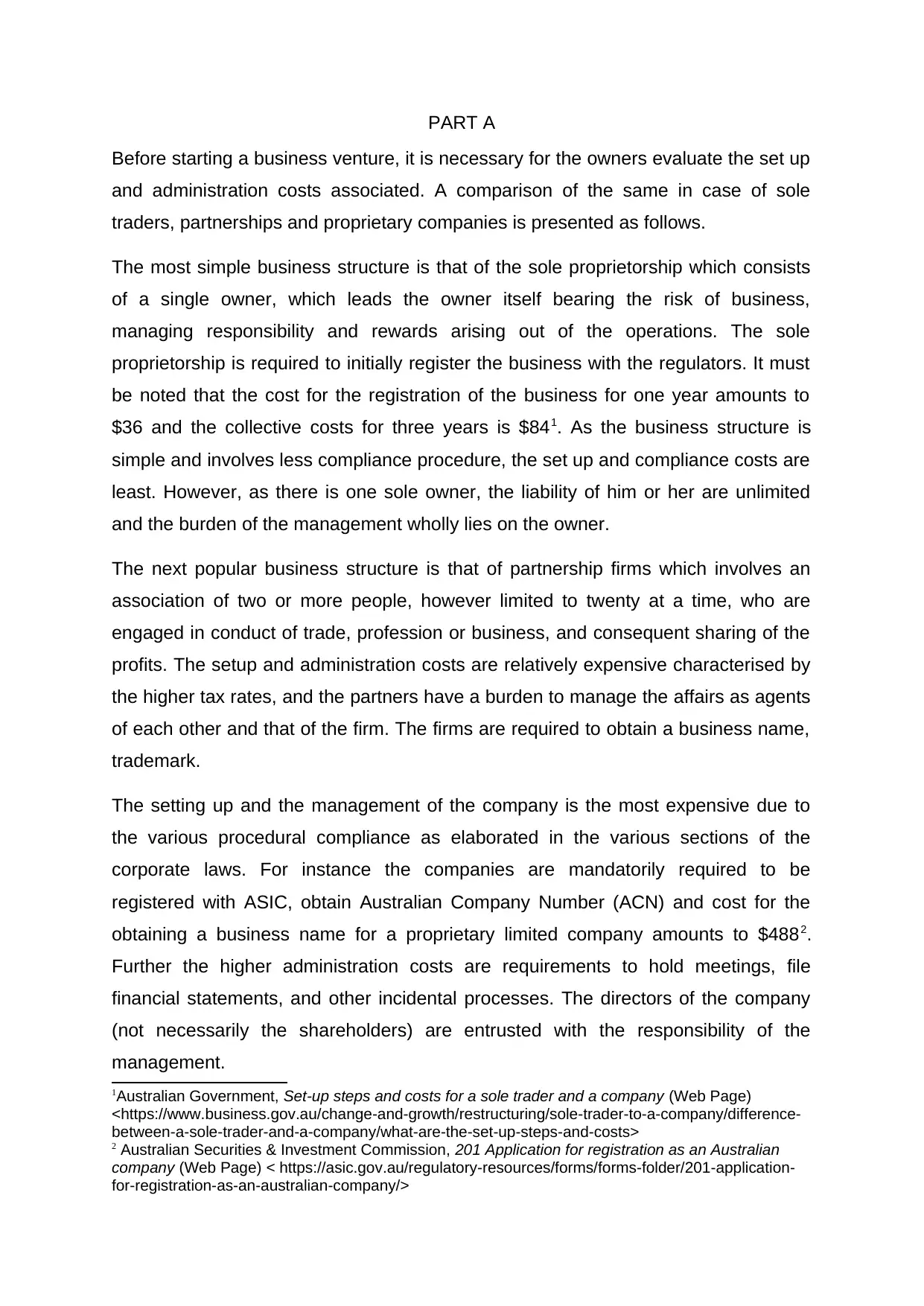
PART A
Before starting a business venture, it is necessary for the owners evaluate the set up
and administration costs associated. A comparison of the same in case of sole
traders, partnerships and proprietary companies is presented as follows.
The most simple business structure is that of the sole proprietorship which consists
of a single owner, which leads the owner itself bearing the risk of business,
managing responsibility and rewards arising out of the operations. The sole
proprietorship is required to initially register the business with the regulators. It must
be noted that the cost for the registration of the business for one year amounts to
$36 and the collective costs for three years is $841. As the business structure is
simple and involves less compliance procedure, the set up and compliance costs are
least. However, as there is one sole owner, the liability of him or her are unlimited
and the burden of the management wholly lies on the owner.
The next popular business structure is that of partnership firms which involves an
association of two or more people, however limited to twenty at a time, who are
engaged in conduct of trade, profession or business, and consequent sharing of the
profits. The setup and administration costs are relatively expensive characterised by
the higher tax rates, and the partners have a burden to manage the affairs as agents
of each other and that of the firm. The firms are required to obtain a business name,
trademark.
The setting up and the management of the company is the most expensive due to
the various procedural compliance as elaborated in the various sections of the
corporate laws. For instance the companies are mandatorily required to be
registered with ASIC, obtain Australian Company Number (ACN) and cost for the
obtaining a business name for a proprietary limited company amounts to $4882.
Further the higher administration costs are requirements to hold meetings, file
financial statements, and other incidental processes. The directors of the company
(not necessarily the shareholders) are entrusted with the responsibility of the
management.
1Australian Government, Set-up steps and costs for a sole trader and a company (Web Page)
<https://www.business.gov.au/change-and-growth/restructuring/sole-trader-to-a-company/difference-
between-a-sole-trader-and-a-company/what-are-the-set-up-steps-and-costs>
2 Australian Securities & Investment Commission, 201 Application for registration as an Australian
company (Web Page) < https://asic.gov.au/regulatory-resources/forms/forms-folder/201-application-
for-registration-as-an-australian-company/>
Before starting a business venture, it is necessary for the owners evaluate the set up
and administration costs associated. A comparison of the same in case of sole
traders, partnerships and proprietary companies is presented as follows.
The most simple business structure is that of the sole proprietorship which consists
of a single owner, which leads the owner itself bearing the risk of business,
managing responsibility and rewards arising out of the operations. The sole
proprietorship is required to initially register the business with the regulators. It must
be noted that the cost for the registration of the business for one year amounts to
$36 and the collective costs for three years is $841. As the business structure is
simple and involves less compliance procedure, the set up and compliance costs are
least. However, as there is one sole owner, the liability of him or her are unlimited
and the burden of the management wholly lies on the owner.
The next popular business structure is that of partnership firms which involves an
association of two or more people, however limited to twenty at a time, who are
engaged in conduct of trade, profession or business, and consequent sharing of the
profits. The setup and administration costs are relatively expensive characterised by
the higher tax rates, and the partners have a burden to manage the affairs as agents
of each other and that of the firm. The firms are required to obtain a business name,
trademark.
The setting up and the management of the company is the most expensive due to
the various procedural compliance as elaborated in the various sections of the
corporate laws. For instance the companies are mandatorily required to be
registered with ASIC, obtain Australian Company Number (ACN) and cost for the
obtaining a business name for a proprietary limited company amounts to $4882.
Further the higher administration costs are requirements to hold meetings, file
financial statements, and other incidental processes. The directors of the company
(not necessarily the shareholders) are entrusted with the responsibility of the
management.
1Australian Government, Set-up steps and costs for a sole trader and a company (Web Page)
<https://www.business.gov.au/change-and-growth/restructuring/sole-trader-to-a-company/difference-
between-a-sole-trader-and-a-company/what-are-the-set-up-steps-and-costs>
2 Australian Securities & Investment Commission, 201 Application for registration as an Australian
company (Web Page) < https://asic.gov.au/regulatory-resources/forms/forms-folder/201-application-
for-registration-as-an-australian-company/>
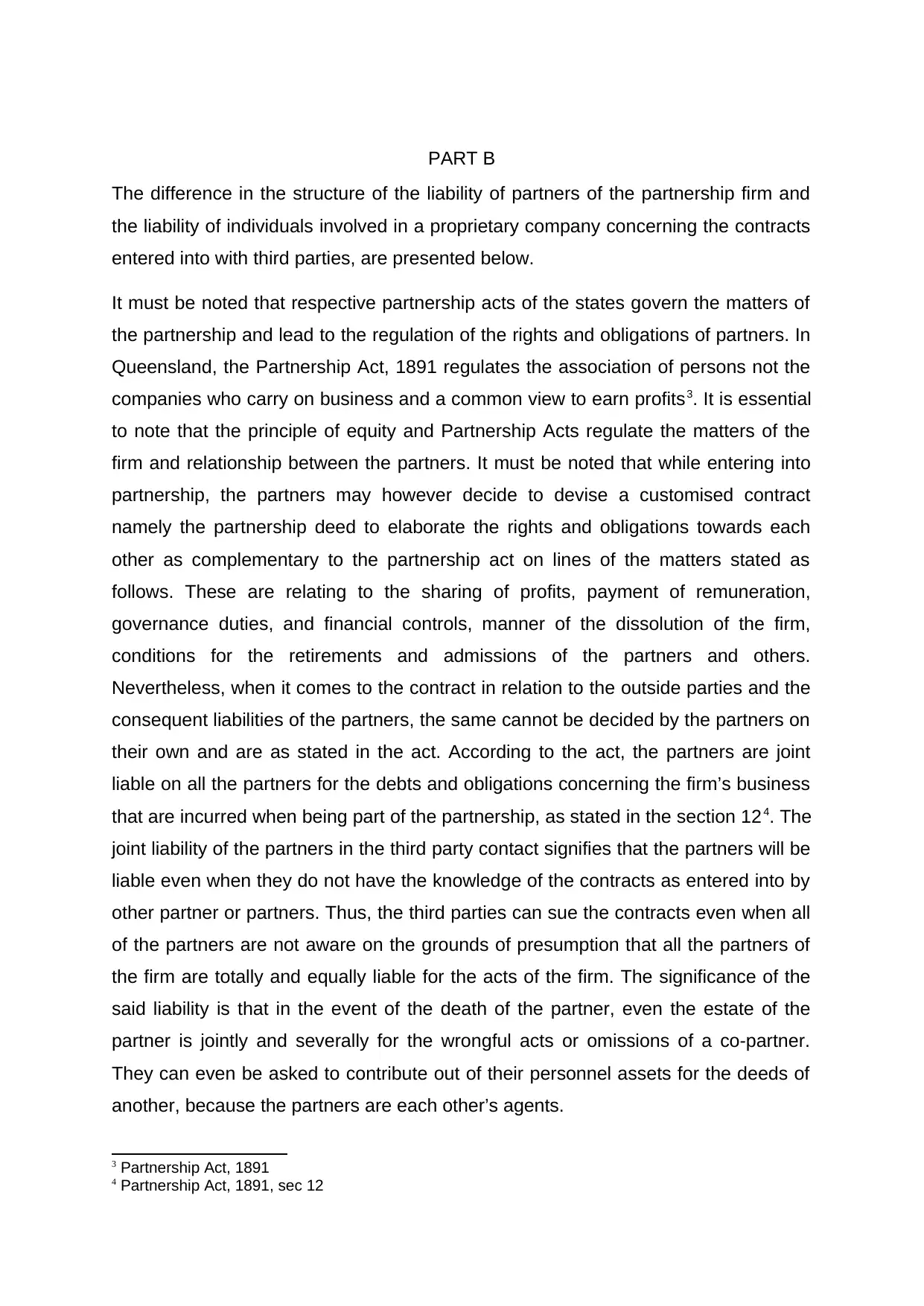
PART B
The difference in the structure of the liability of partners of the partnership firm and
the liability of individuals involved in a proprietary company concerning the contracts
entered into with third parties, are presented below.
It must be noted that respective partnership acts of the states govern the matters of
the partnership and lead to the regulation of the rights and obligations of partners. In
Queensland, the Partnership Act, 1891 regulates the association of persons not the
companies who carry on business and a common view to earn profits3. It is essential
to note that the principle of equity and Partnership Acts regulate the matters of the
firm and relationship between the partners. It must be noted that while entering into
partnership, the partners may however decide to devise a customised contract
namely the partnership deed to elaborate the rights and obligations towards each
other as complementary to the partnership act on lines of the matters stated as
follows. These are relating to the sharing of profits, payment of remuneration,
governance duties, and financial controls, manner of the dissolution of the firm,
conditions for the retirements and admissions of the partners and others.
Nevertheless, when it comes to the contract in relation to the outside parties and the
consequent liabilities of the partners, the same cannot be decided by the partners on
their own and are as stated in the act. According to the act, the partners are joint
liable on all the partners for the debts and obligations concerning the firm’s business
that are incurred when being part of the partnership, as stated in the section 124. The
joint liability of the partners in the third party contact signifies that the partners will be
liable even when they do not have the knowledge of the contracts as entered into by
other partner or partners. Thus, the third parties can sue the contracts even when all
of the partners are not aware on the grounds of presumption that all the partners of
the firm are totally and equally liable for the acts of the firm. The significance of the
said liability is that in the event of the death of the partner, even the estate of the
partner is jointly and severally for the wrongful acts or omissions of a co-partner.
They can even be asked to contribute out of their personnel assets for the deeds of
another, because the partners are each other’s agents.
3 Partnership Act, 1891
4 Partnership Act, 1891, sec 12
The difference in the structure of the liability of partners of the partnership firm and
the liability of individuals involved in a proprietary company concerning the contracts
entered into with third parties, are presented below.
It must be noted that respective partnership acts of the states govern the matters of
the partnership and lead to the regulation of the rights and obligations of partners. In
Queensland, the Partnership Act, 1891 regulates the association of persons not the
companies who carry on business and a common view to earn profits3. It is essential
to note that the principle of equity and Partnership Acts regulate the matters of the
firm and relationship between the partners. It must be noted that while entering into
partnership, the partners may however decide to devise a customised contract
namely the partnership deed to elaborate the rights and obligations towards each
other as complementary to the partnership act on lines of the matters stated as
follows. These are relating to the sharing of profits, payment of remuneration,
governance duties, and financial controls, manner of the dissolution of the firm,
conditions for the retirements and admissions of the partners and others.
Nevertheless, when it comes to the contract in relation to the outside parties and the
consequent liabilities of the partners, the same cannot be decided by the partners on
their own and are as stated in the act. According to the act, the partners are joint
liable on all the partners for the debts and obligations concerning the firm’s business
that are incurred when being part of the partnership, as stated in the section 124. The
joint liability of the partners in the third party contact signifies that the partners will be
liable even when they do not have the knowledge of the contracts as entered into by
other partner or partners. Thus, the third parties can sue the contracts even when all
of the partners are not aware on the grounds of presumption that all the partners of
the firm are totally and equally liable for the acts of the firm. The significance of the
said liability is that in the event of the death of the partner, even the estate of the
partner is jointly and severally for the wrongful acts or omissions of a co-partner.
They can even be asked to contribute out of their personnel assets for the deeds of
another, because the partners are each other’s agents.
3 Partnership Act, 1891
4 Partnership Act, 1891, sec 12
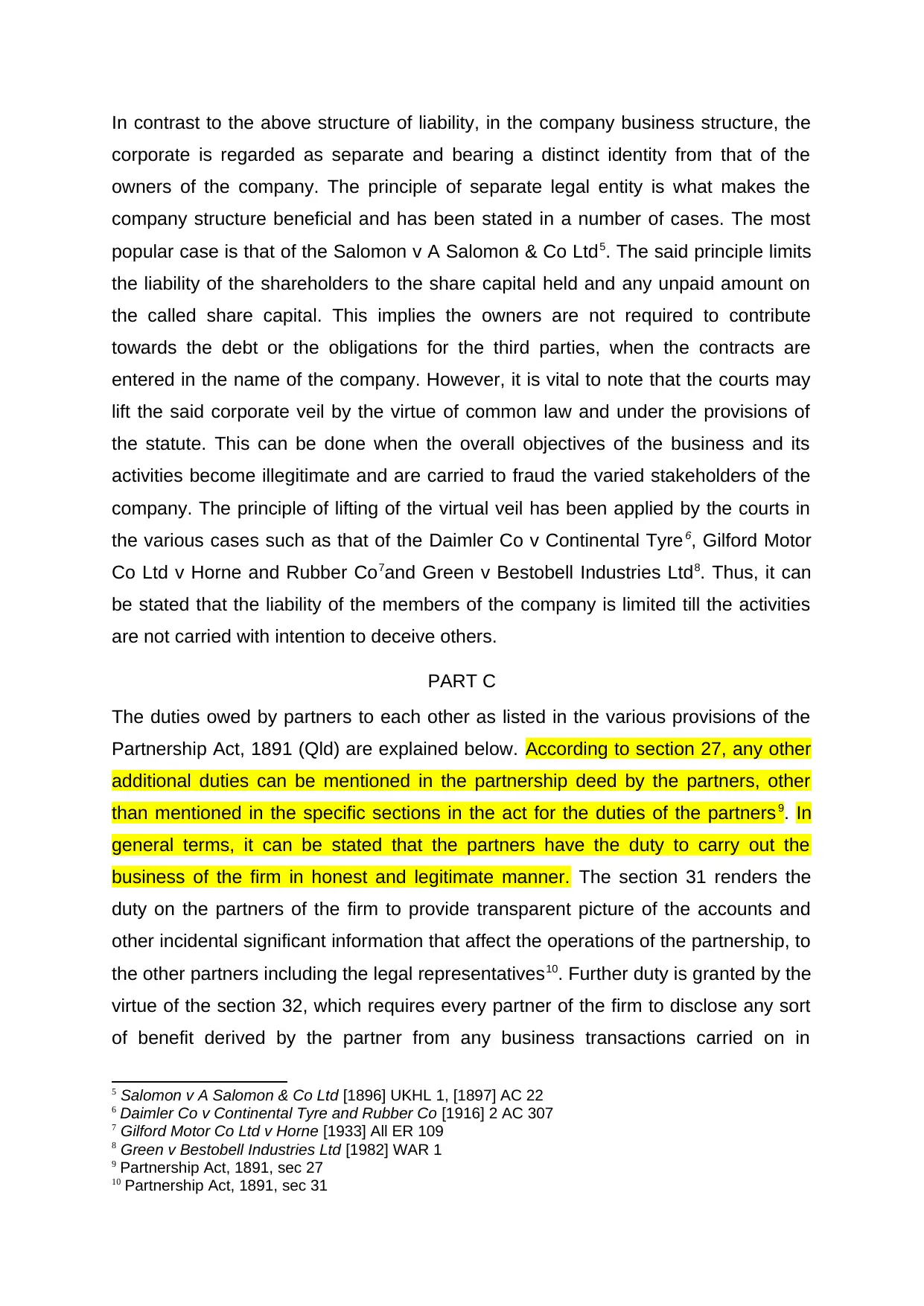
In contrast to the above structure of liability, in the company business structure, the
corporate is regarded as separate and bearing a distinct identity from that of the
owners of the company. The principle of separate legal entity is what makes the
company structure beneficial and has been stated in a number of cases. The most
popular case is that of the Salomon v A Salomon & Co Ltd5. The said principle limits
the liability of the shareholders to the share capital held and any unpaid amount on
the called share capital. This implies the owners are not required to contribute
towards the debt or the obligations for the third parties, when the contracts are
entered in the name of the company. However, it is vital to note that the courts may
lift the said corporate veil by the virtue of common law and under the provisions of
the statute. This can be done when the overall objectives of the business and its
activities become illegitimate and are carried to fraud the varied stakeholders of the
company. The principle of lifting of the virtual veil has been applied by the courts in
the various cases such as that of the Daimler Co v Continental Tyre 6, Gilford Motor
Co Ltd v Horne and Rubber Co7and Green v Bestobell Industries Ltd8. Thus, it can
be stated that the liability of the members of the company is limited till the activities
are not carried with intention to deceive others.
PART C
The duties owed by partners to each other as listed in the various provisions of the
Partnership Act, 1891 (Qld) are explained below. According to section 27, any other
additional duties can be mentioned in the partnership deed by the partners, other
than mentioned in the specific sections in the act for the duties of the partners 9. In
general terms, it can be stated that the partners have the duty to carry out the
business of the firm in honest and legitimate manner. The section 31 renders the
duty on the partners of the firm to provide transparent picture of the accounts and
other incidental significant information that affect the operations of the partnership, to
the other partners including the legal representatives10. Further duty is granted by the
virtue of the section 32, which requires every partner of the firm to disclose any sort
of benefit derived by the partner from any business transactions carried on in
5 Salomon v A Salomon & Co Ltd [1896] UKHL 1, [1897] AC 22
6 Daimler Co v Continental Tyre and Rubber Co [1916] 2 AC 307
7 Gilford Motor Co Ltd v Horne [1933] All ER 109
8 Green v Bestobell Industries Ltd [1982] WAR 1
9 Partnership Act, 1891, sec 27
10 Partnership Act, 1891, sec 31
corporate is regarded as separate and bearing a distinct identity from that of the
owners of the company. The principle of separate legal entity is what makes the
company structure beneficial and has been stated in a number of cases. The most
popular case is that of the Salomon v A Salomon & Co Ltd5. The said principle limits
the liability of the shareholders to the share capital held and any unpaid amount on
the called share capital. This implies the owners are not required to contribute
towards the debt or the obligations for the third parties, when the contracts are
entered in the name of the company. However, it is vital to note that the courts may
lift the said corporate veil by the virtue of common law and under the provisions of
the statute. This can be done when the overall objectives of the business and its
activities become illegitimate and are carried to fraud the varied stakeholders of the
company. The principle of lifting of the virtual veil has been applied by the courts in
the various cases such as that of the Daimler Co v Continental Tyre 6, Gilford Motor
Co Ltd v Horne and Rubber Co7and Green v Bestobell Industries Ltd8. Thus, it can
be stated that the liability of the members of the company is limited till the activities
are not carried with intention to deceive others.
PART C
The duties owed by partners to each other as listed in the various provisions of the
Partnership Act, 1891 (Qld) are explained below. According to section 27, any other
additional duties can be mentioned in the partnership deed by the partners, other
than mentioned in the specific sections in the act for the duties of the partners 9. In
general terms, it can be stated that the partners have the duty to carry out the
business of the firm in honest and legitimate manner. The section 31 renders the
duty on the partners of the firm to provide transparent picture of the accounts and
other incidental significant information that affect the operations of the partnership, to
the other partners including the legal representatives10. Further duty is granted by the
virtue of the section 32, which requires every partner of the firm to disclose any sort
of benefit derived by the partner from any business transactions carried on in
5 Salomon v A Salomon & Co Ltd [1896] UKHL 1, [1897] AC 22
6 Daimler Co v Continental Tyre and Rubber Co [1916] 2 AC 307
7 Gilford Motor Co Ltd v Horne [1933] All ER 109
8 Green v Bestobell Industries Ltd [1982] WAR 1
9 Partnership Act, 1891, sec 27
10 Partnership Act, 1891, sec 31
Secure Best Marks with AI Grader
Need help grading? Try our AI Grader for instant feedback on your assignments.
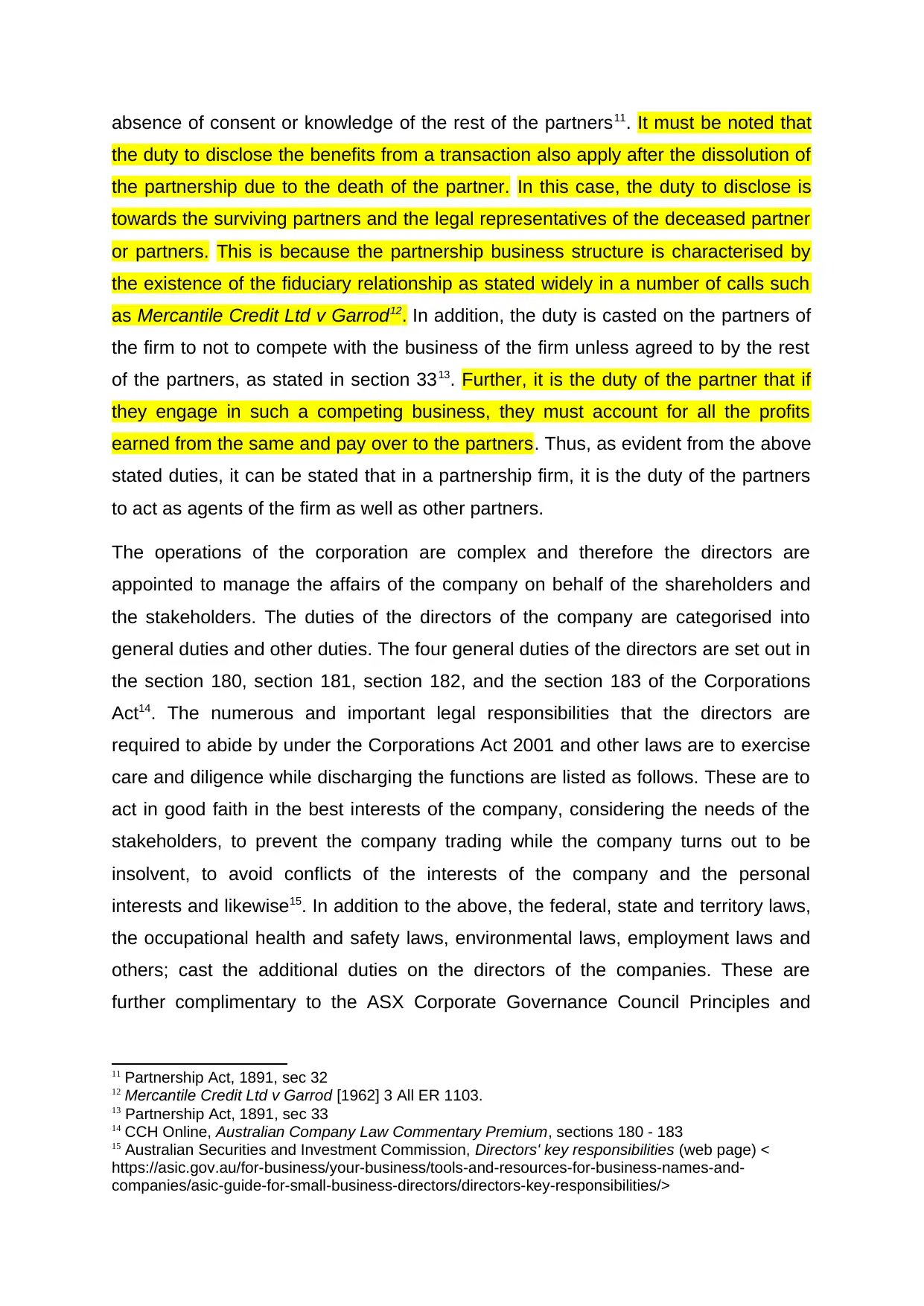
absence of consent or knowledge of the rest of the partners11. It must be noted that
the duty to disclose the benefits from a transaction also apply after the dissolution of
the partnership due to the death of the partner. In this case, the duty to disclose is
towards the surviving partners and the legal representatives of the deceased partner
or partners. This is because the partnership business structure is characterised by
the existence of the fiduciary relationship as stated widely in a number of calls such
as Mercantile Credit Ltd v Garrod12. In addition, the duty is casted on the partners of
the firm to not to compete with the business of the firm unless agreed to by the rest
of the partners, as stated in section 3313. Further, it is the duty of the partner that if
they engage in such a competing business, they must account for all the profits
earned from the same and pay over to the partners. Thus, as evident from the above
stated duties, it can be stated that in a partnership firm, it is the duty of the partners
to act as agents of the firm as well as other partners.
The operations of the corporation are complex and therefore the directors are
appointed to manage the affairs of the company on behalf of the shareholders and
the stakeholders. The duties of the directors of the company are categorised into
general duties and other duties. The four general duties of the directors are set out in
the section 180, section 181, section 182, and the section 183 of the Corporations
Act14. The numerous and important legal responsibilities that the directors are
required to abide by under the Corporations Act 2001 and other laws are to exercise
care and diligence while discharging the functions are listed as follows. These are to
act in good faith in the best interests of the company, considering the needs of the
stakeholders, to prevent the company trading while the company turns out to be
insolvent, to avoid conflicts of the interests of the company and the personal
interests and likewise15. In addition to the above, the federal, state and territory laws,
the occupational health and safety laws, environmental laws, employment laws and
others; cast the additional duties on the directors of the companies. These are
further complimentary to the ASX Corporate Governance Council Principles and
11 Partnership Act, 1891, sec 32
12 Mercantile Credit Ltd v Garrod [1962] 3 All ER 1103.
13 Partnership Act, 1891, sec 33
14 CCH Online, Australian Company Law Commentary Premium, sections 180 - 183
15 Australian Securities and Investment Commission, Directors' key responsibilities (web page) <
https://asic.gov.au/for-business/your-business/tools-and-resources-for-business-names-and-
companies/asic-guide-for-small-business-directors/directors-key-responsibilities/>
the duty to disclose the benefits from a transaction also apply after the dissolution of
the partnership due to the death of the partner. In this case, the duty to disclose is
towards the surviving partners and the legal representatives of the deceased partner
or partners. This is because the partnership business structure is characterised by
the existence of the fiduciary relationship as stated widely in a number of calls such
as Mercantile Credit Ltd v Garrod12. In addition, the duty is casted on the partners of
the firm to not to compete with the business of the firm unless agreed to by the rest
of the partners, as stated in section 3313. Further, it is the duty of the partner that if
they engage in such a competing business, they must account for all the profits
earned from the same and pay over to the partners. Thus, as evident from the above
stated duties, it can be stated that in a partnership firm, it is the duty of the partners
to act as agents of the firm as well as other partners.
The operations of the corporation are complex and therefore the directors are
appointed to manage the affairs of the company on behalf of the shareholders and
the stakeholders. The duties of the directors of the company are categorised into
general duties and other duties. The four general duties of the directors are set out in
the section 180, section 181, section 182, and the section 183 of the Corporations
Act14. The numerous and important legal responsibilities that the directors are
required to abide by under the Corporations Act 2001 and other laws are to exercise
care and diligence while discharging the functions are listed as follows. These are to
act in good faith in the best interests of the company, considering the needs of the
stakeholders, to prevent the company trading while the company turns out to be
insolvent, to avoid conflicts of the interests of the company and the personal
interests and likewise15. In addition to the above, the federal, state and territory laws,
the occupational health and safety laws, environmental laws, employment laws and
others; cast the additional duties on the directors of the companies. These are
further complimentary to the ASX Corporate Governance Council Principles and
11 Partnership Act, 1891, sec 32
12 Mercantile Credit Ltd v Garrod [1962] 3 All ER 1103.
13 Partnership Act, 1891, sec 33
14 CCH Online, Australian Company Law Commentary Premium, sections 180 - 183
15 Australian Securities and Investment Commission, Directors' key responsibilities (web page) <
https://asic.gov.au/for-business/your-business/tools-and-resources-for-business-names-and-
companies/asic-guide-for-small-business-directors/directors-key-responsibilities/>
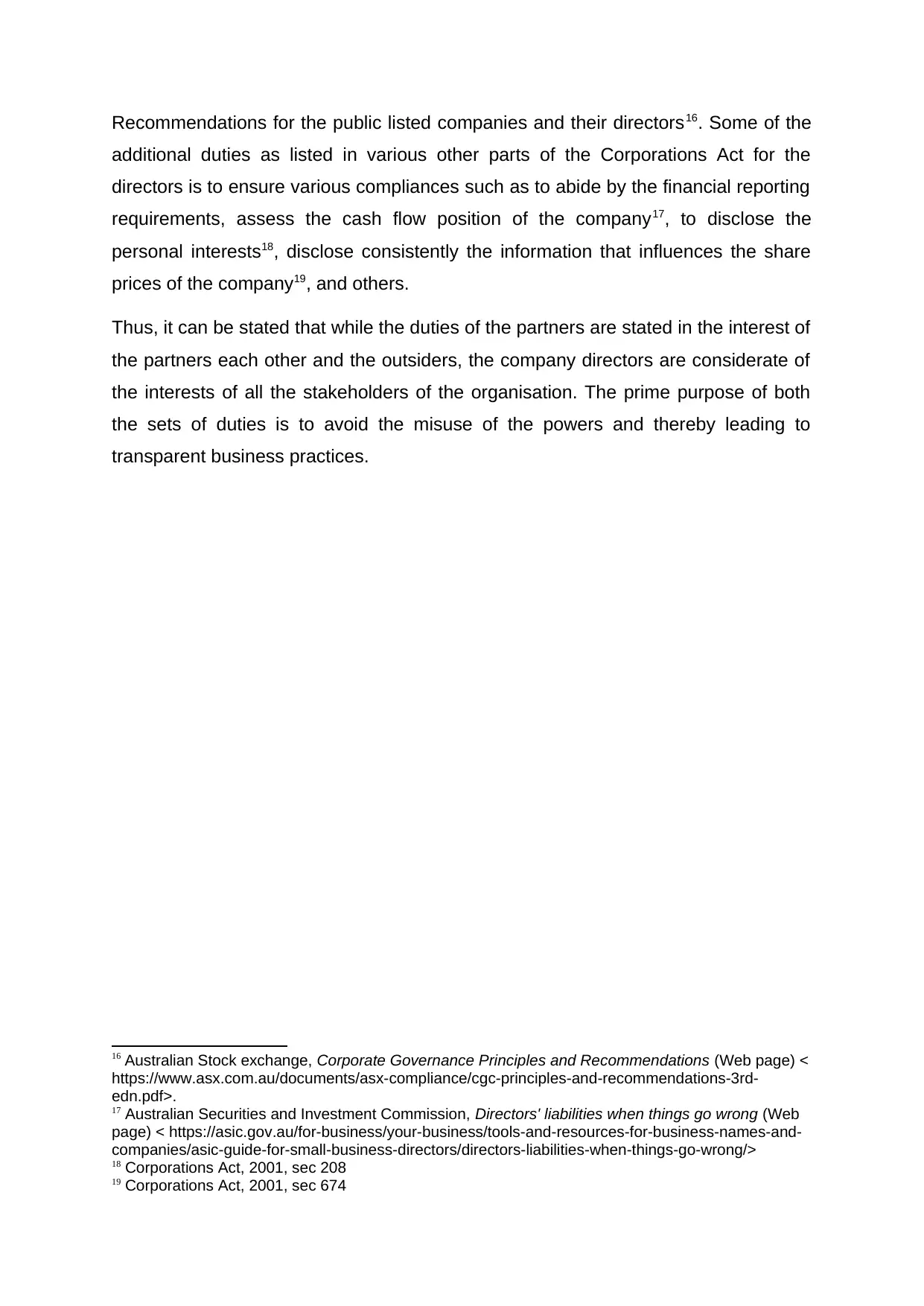
Recommendations for the public listed companies and their directors16. Some of the
additional duties as listed in various other parts of the Corporations Act for the
directors is to ensure various compliances such as to abide by the financial reporting
requirements, assess the cash flow position of the company17, to disclose the
personal interests18, disclose consistently the information that influences the share
prices of the company19, and others.
Thus, it can be stated that while the duties of the partners are stated in the interest of
the partners each other and the outsiders, the company directors are considerate of
the interests of all the stakeholders of the organisation. The prime purpose of both
the sets of duties is to avoid the misuse of the powers and thereby leading to
transparent business practices.
16 Australian Stock exchange, Corporate Governance Principles and Recommendations (Web page) <
https://www.asx.com.au/documents/asx-compliance/cgc-principles-and-recommendations-3rd-
edn.pdf>.
17 Australian Securities and Investment Commission, Directors' liabilities when things go wrong (Web
page) < https://asic.gov.au/for-business/your-business/tools-and-resources-for-business-names-and-
companies/asic-guide-for-small-business-directors/directors-liabilities-when-things-go-wrong/>
18 Corporations Act, 2001, sec 208
19 Corporations Act, 2001, sec 674
additional duties as listed in various other parts of the Corporations Act for the
directors is to ensure various compliances such as to abide by the financial reporting
requirements, assess the cash flow position of the company17, to disclose the
personal interests18, disclose consistently the information that influences the share
prices of the company19, and others.
Thus, it can be stated that while the duties of the partners are stated in the interest of
the partners each other and the outsiders, the company directors are considerate of
the interests of all the stakeholders of the organisation. The prime purpose of both
the sets of duties is to avoid the misuse of the powers and thereby leading to
transparent business practices.
16 Australian Stock exchange, Corporate Governance Principles and Recommendations (Web page) <
https://www.asx.com.au/documents/asx-compliance/cgc-principles-and-recommendations-3rd-
edn.pdf>.
17 Australian Securities and Investment Commission, Directors' liabilities when things go wrong (Web
page) < https://asic.gov.au/for-business/your-business/tools-and-resources-for-business-names-and-
companies/asic-guide-for-small-business-directors/directors-liabilities-when-things-go-wrong/>
18 Corporations Act, 2001, sec 208
19 Corporations Act, 2001, sec 674
1 out of 6
Related Documents
Your All-in-One AI-Powered Toolkit for Academic Success.
+13062052269
info@desklib.com
Available 24*7 on WhatsApp / Email
![[object Object]](/_next/static/media/star-bottom.7253800d.svg)
Unlock your academic potential
© 2024 | Zucol Services PVT LTD | All rights reserved.





